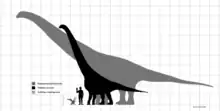Shengjinkou Formation
The Shengjinkou Formation is an Early Cretaceous (Aptian)-aged Konservat-Lagerstätte composed of "interbedded red green and yellow variegated mudstones and siltstones" that is part of the larger Tugulu Group of China.[1][2] Dinosaur[3] and pterosaur remains have been recovered from the formation.[4][5]
| Shengjinkou Formation | |
|---|---|
| Stratigraphic range: Early Cretaceous, ~ | |
| Type | Geological formation |
| Unit of | Tugulu Group |
| Underlies | Lianmuqin Formation |
| Overlies | Kalaza Formation |
| Lithology | |
| Primary | Mudstone, siltstone |
| Location | |
| Coordinates | 46.0°N 85.8°E |
| Approximate paleocoordinates | 45.0°N 81.9°E |
| Region | Xinjiang Uygur Autonomous Region |
| Country | |
| Extent | Junggar Basin |
 Shengjinkou Formation (دزونگاريا ) | |
History
The Shengjikou Formation was first identified in a 1956 manuscript by Xia Gongjun. The type locality is near Turpan City in the Xinjiang Region of China.[5]
In 2006 from the Hami region in Xinjiang, the Shengjinkou Formation, a Konservat-Lagerstätte was reported, in this case lake sediments allowing for an exceptional preservation of fossils. The same year, Qiu Zhanxiang and Wang Banyue started official excavations. Part of the finds consisted of dense concentrations of pterosaur bones, associated with soft tissues and eggs. The site represented a nesting colony that storm floods had covered with mud. Dozens of individuals could be secured from a total that in 2014 was estimated to run into the many hundreds.[4] Dinosaur fossils were first reported from the formation in 2021.[3]
Paleofauna

- Hamipterus tianshanensis[4]
- Hamititan xinjiangensis[3]
- Silutitan sinensis[3]
- Somphospondyli (?) indet. (=Sauropoda indet.)[3]
- Theropoda indet.[3]
References
- Lucas, Spencer G, Chinese Fossil vertebrates, Pp. 158-159, New York, Columbia University Press, ISBN 0-231-08483-8.
- Lucas, S.G. (2001). Chinese Fossil Vertebrates. Columbia University Press. p. 158. ISBN 9780231084833. Retrieved 2015-01-05.
- Wang X, Bandeira KL, Qiu R, Jiang S, Cheng X, Ma Y, Kellner AW (2021). "The first dinosaurs from the Early Cretaceous Hami Pterosaur Fauna, China". Scientific Reports. 11 (1): Article number 14962. doi:10.1038/s41598-021-94273-7. PMC 8361124.
- Wang X, Kellner AW, Jiang S, Wang Q, Ma Y, Paidoula Y, et al. (June 2014). "Sexually dimorphic tridimensionally preserved pterosaurs and their eggs from China". Current Biology. 24 (12): 1323–1330. doi:10.1016/j.cub.2014.04.054. PMID 24909325.
-
- Weishampel, David B.; Peter Dodson, and Halszka Osmólska (eds.). 2004. The Dinosauria, 2nd edition, 517-607. Berkeley: University of California Press. Accessed 2019-02-21. ISBN 0-520-24209-2